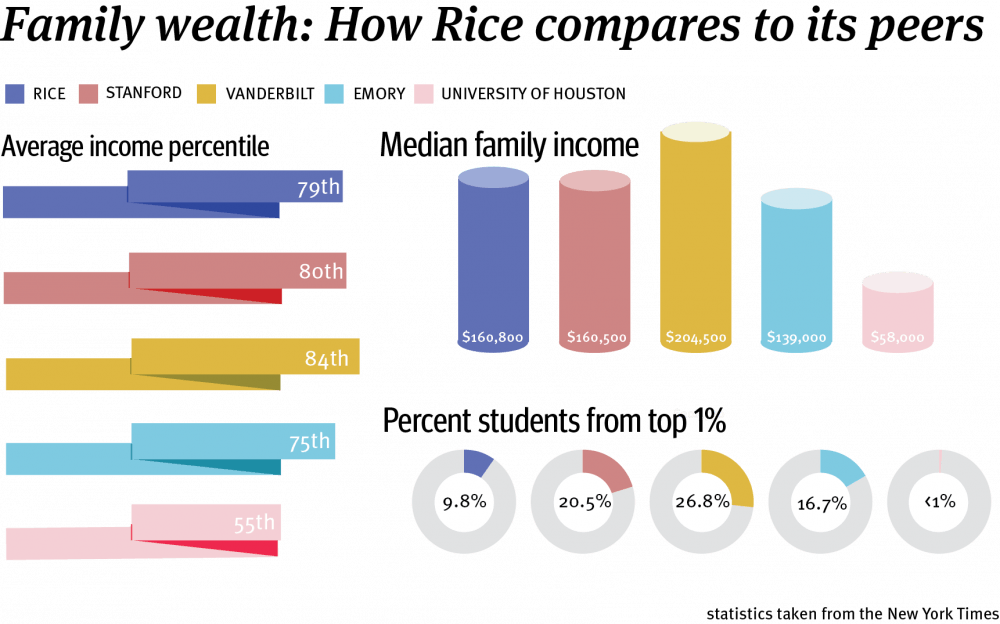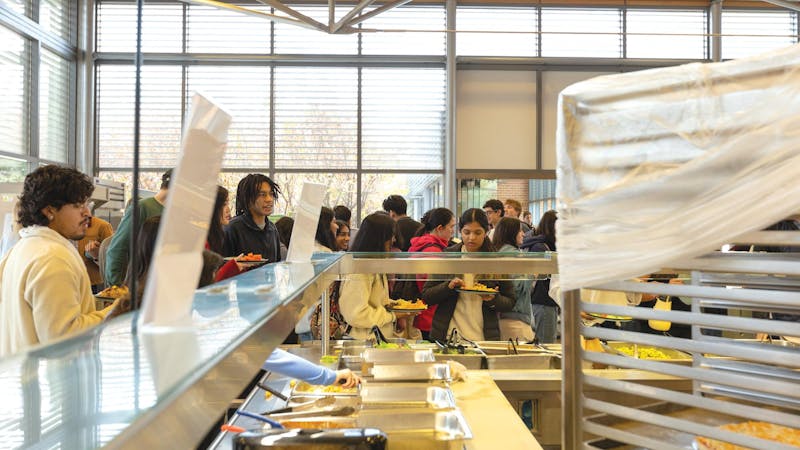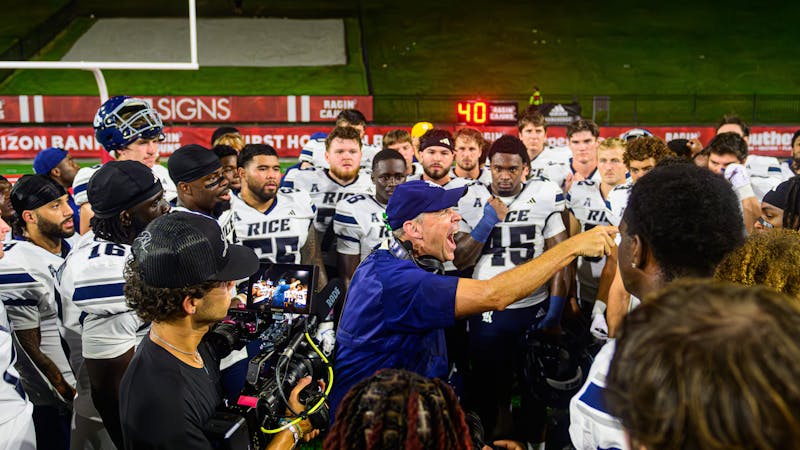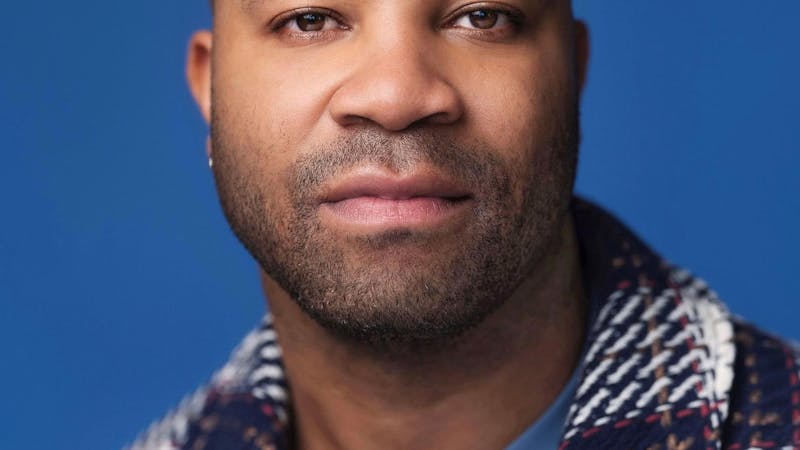Princeton Review race/class ranking at odds with mobility metrics

Following Rice University’s No. 1 ranking for race and class interaction by the Princeton Review in August 2016, a recent study reported by the New York Times of 2,137 universities revealed that Rice is approximately average in terms of class financial composition and mobility when compared to other elite institutions.
The study, conducted by the Equality of Opportunity Project, used administrative data for college students from 1999 to 2013 to create mobility report cards that compared students’ earnings to their parents’ incomes. The study compared Rice compared with other colleges classified as “elite schools.”
According to the article, 9.8 percent of Rice students come from the top 1 percent of median family income, which is $630,000 or above per year, and 35 percent come from the top 5 percent, earning $110,000 or more per year. Rice has a relatively high percentage of students from the bottom fifth of income, coming in 11th among other elite colleges at 4.9 percent of the student body.
Compared to peer institutions such as Vanderbilt University and Duke University, Rice has a lower percentage of the student body from the top 1 and top 5 percents of median family income. 23 percent of Vanderbilt students came from the top 1 percent and 47 percent came from the top five percent. 19 percent of Duke students are from the top 1 percent and 44 percent from the top 5 percent. Overall, Rice ranks 45th of the 65 “elite colleges,” as defined by the Equality of Opportunity project, for both share of students in the top 1 percent and top 5 percent.
Rice ranked 40th out of 64 elite colleges for percentage of students moving from the bottom to the top income quintile, with 1.6 percent making this move. The study showed 14 percent of Rice students move up two more more quintiles in income and ranked Rice 22nd out of the 64 elite colleges in this category.
According to the study, at age 34, the median income of male and female alumni at Rice is $88,800 and $67,900, respectively. 17 percent of Rice students end up in the top 1 percent, 50 percent end up in the top 10 percent and 7.1 percent end up in the bottom 20 percent. After graduating, the average income percentile of a rich student is the 78th and the average income percentile of a poor student is the 71st.
Amina Williams, a diversity facilitator at McMurtry College, said the number of high-income students at Rice is noticeable.
“It’s very obvious that the majority of people at Rice come from well-off backgrounds,” Williams, a sophomore, said. “That’s something I noticed right away at [Orientation Week], even with the way people speak.”
Williams said it would be helpful if Rice offered assistance for fees associated with textbooks, Saturday night dinners and social events such as Esperanza.
“I’ve definitely felt that I can’t fully experience what [other students are] experiencing because of where I come from,” Williams said.
Last semester, the Student Association’s Student Access and Success Report revealed that almost 60 percent of students with a household income of $50,000 or lower are unable to participate in Rice events, such as Beer Bike and Alternative Spring Break. The report prompted the SA to implement changes such as on campus Saturday night dinners.
SA President Griffin Thomas said the report prompted the SA to work with offices ranging from the Center for Career Development to the academic schools. According to Thomas, there are no longer costs for cocurricular activities within the School of Social Sciences.
“We have also been working closely with the the Provost’s Office on a project that would more dramatically and holistically support low-income students,” Thomas, a Lovett College senior, said.
According to Thomas, in response to the SA’s findings, Dean of Undergraduates John Hutchinson launched an initiative to provide $500 of funding to each residential colleges, to be used to lower costs of participating in voluntary college events. Discussions on how to defray such costs are ongoing at several colleges.
In the Princeton Review’s 2017 edition of “The Best 381 Colleges,” Rice ranked first for the second year for “lots of race and class interaction.”
Williams said many of her friends were surprised when the Princeton Review rankings came out, expressing confusion about which students were interviewed. She noted that it might be easier for low-income students to detect the divide.
Unlike Williams, diveresity facilitator Josiah Yarbrough said he was not surprised by Rice’s Princeton Review Ranking.
“My experience at Rice has shown me that students here are often more than accepting,” Yarbrough, a Will Rice College junior, said. “However, I think Rice is made great in this area not only because of how it currently treats students, but also because we as a student body recognize that more needs to be done.”
Yarbrough said he he has seen students taking steps to improve the Rice experience this year.
“I love how recent conversations have led to action in making more accessible to low-income students,” Yarbrough said. “It’s encouraging to know that campus leaders are willing to listen to the concerns of disadvantaged groups.”
The Princeton Review ranking is based on how strongly students agree or disagree with the statement, “Different types of students (black/white, rich/poor) interact frequently and easily.”
Associate Dean of Undergraduates Catherine Clack, who directs the Office of Multicultural Affairs, said she believes the residential colleges are the most influential factor in establishing an attitude of inclusion.
The residential college system, created in 1957, replaces the role of fraternities and sororities as centers of social interaction, preventing the grouping together of “like” students, Clack said.
Duncan College O-Week 2016 coordinator Bradley Hamilton said diversity is a priority for O-Week during advisor selection, event planning and group and roommate pairing.
Despite this emphasis, Clack feels Rice’s high ranking in the Princeton Review study does not necessarily accurately reflect deeper connections between students of different backgrounds.
“Are close friendships really that diverse?” Clack said. “Do they have a greater knowledge and appreciation for cultural and class difference? That would be a more insightful measure.”
Hamilton, a senior, said diversity should not be mistaken for inclusivity.
“We have fallen into this mindset where we assume everyone falls into the ‘Rice mentality’ or ‘Rice personality,’” Hamilton said. “That is completely untrue, and by believing in such a falsehood, we have left too many students on the outskirts of the social culture of our university.”
Hamilton stressed the importance of fighting passivity and reluctance to speak up in public settings by engaging in conversations that can be uncomfortable at times.
The Office of Multicultural Affairs sponsors the O-Week diversity facilitators, a select group of students who lead these difficult conversations during O-Week and beyond.
Williams said her role is important, but the experience has been slightly disappointing.
“As a [diversity facilitator], I can only reach the people if they want to learn,” Williams said. “Usually the people who really need to hear certain things aren’t very open to it, and I can’t really do anything about that.”
Williams said she envisions the role of the diversity facilitator as a resource and role model.
“We can’t be everywhere, but if there’s someone out there who learned from us, they can feel empowered enough to do what we’re doing, on a smaller scale,” Williams said.
Associate Provost and founder of the Office of Diversity and Inclusion Roland Smith said the Princeton Review ranking is indicative of a noteworthy long-term shift towards diversity.
“I always look at those titles with a grain of salt, but I think symbolically, they express something that’s here,” Smith said. “We are much more diverse now than when I came here 20 years ago. I’ve actually seen, or felt, the climate change.”
Smith said he believes there is still a lack of faculty and graduate student diversity at Rice, which he attributes to the lack of exposure to academia as a possible career choice.
“We need to do more in the way of producing and encouraging students in going into academic and research fields,” Smith said. “We don’t tout it enough to underrepresented communities.”
Since its foundation in 1988, the OMA has worked towards increasing the depth of interaction by providing financial and logistical support for multicultural student organizations.
One of the student groups that the OMA works with, the Hispanic Association for Cultural Education at Rice, seeks to promote Hispanic culture within the Rice community through social and cultural events.
As co-president of HACER, Juan Valenzuela said his goal is to keep providing opportunities for students to become exposed to Hispanic and Latin-American cultures.
“I’ve found that certain topics of discussion make some people immediately disengage from conversation,” Valenzuela, a Lovett junior, said. “I believe that by providing these opportunities to students, we can get around the usual reticence that surrounds topics of multiculturalism and diversity.”
Though the admissions office has implemented policies to increase recruitment of students from various backgrounds, Hutchinson emphasized that having an accepting community is more important than just demographics.
“A diverse community only works if the community embraces that diversity,” he said.
More from The Rice Thresher

Over 1,000 students petition against new meal plan
When Konstantin Savvon opened the Housing and Dining email announcing the new unlimited meal plan, he was instantly concerned about the impact on off-campus students like himself.

Rice football wins season opener under new coach
For the first time since 2018, Rice football opened its season with a victory. Scott Abell was soaked with yellow Powerade following a 14-12 win on the road Saturday against the University of Louisiana at Lafayette, which won 10 games and made it to the Sun Belt Conference championship last season.

Acting like an athlete: Rice basketball alum takes on Broadway
Underneath Chadd Alexander’s Broadway costume, there’s ankle tape and wrist braces — same protective gear he wore as a walk-on basketball player at Rice, though now he’s performing eight shows a week in the ensemble of “Harry Potter and the Cursed Child” instead of running conditioning drills in Tudor Fieldhouse.

Please note All comments are eligible for publication by The Rice Thresher.